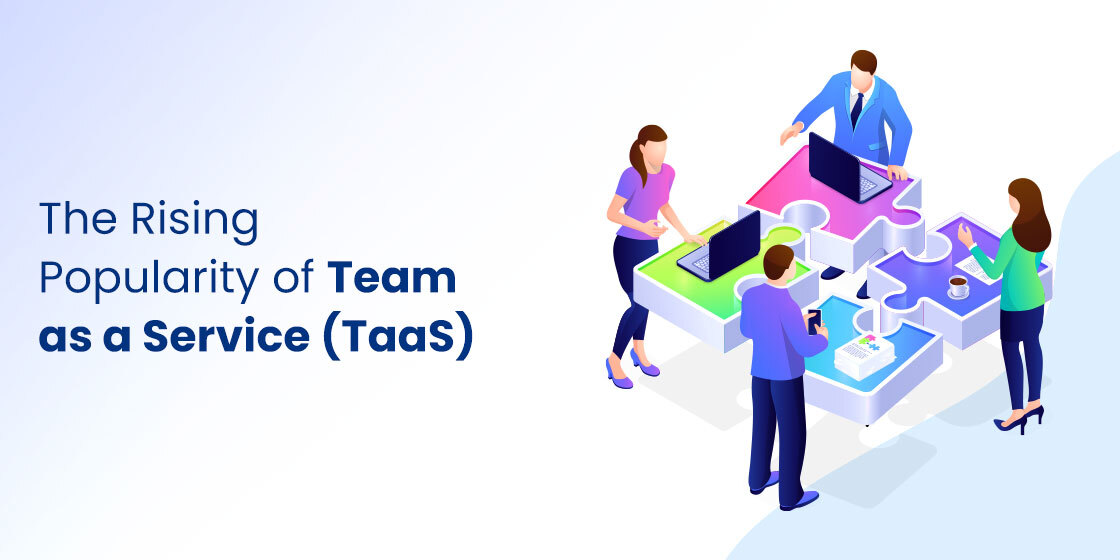Table Of Content
Discover How the Team as a Service Model Can Help Your Business Grow
Businesses globally are striving to adapt to the changing landscape, and reduce their overheads by being agile. However, for many businesses, that means existing resources are assigned more work and responsibilities, which can quickly lead to burnout.
The crux of the matter is that these additional tasks and responsibilities usually occur sporadically, which means that situations requiring additional resources are often temporary. So how can you as a business bridge this gap? How can you reduce your costs and overheads while still having the resources available to work when needed?
One of the most popular ways to do that is through Team as a Service, or TaaS.
The most common technique used by businesses who want to reduce costs while hiring bigger teams is to use some form of outsourcing. However, that can result in a variety of different issues, including supervision issues, contract problems, and more. And that is where TaaS comes in. It allows businesses to have the benefit of additional resources without worrying about contract issues, employee overheads, and more.
So, let’s dive in and discover how software outsourcing services use Team as a Service model to help their clients boost their ROI in this fast-paced business environment.
What is Team as a Service (TaaS) Model?

When we talk about TaaS, or Team as a Service, many people are confused about what it entails. well, in order to understand the concept, we need to draw from our knowledge of SaaS or Software as a Service. When we say “as a Service”, it means that the thing we are referring to is ready and able for plug-and-play.
That means that when needed, it can be integrated and powered on without worrying about training people or hiring specialized people for it. Similarly, once done, it should also be easy to remove or disconnect from your main product.
Coming back to Team as a Service, this refers to a ready-built team that can jump in and handle a project when needed, and once done, can be removed without affecting operations. Ideally, a business using TaaS would prefer the team working on their project to be exclusive to their organization. However, in reality, that is not the case.
Despite that, some IT project outsourcing providers offer dedicated teams for enterprises who prefer it. in such cases, the teams work full time or that specific client, while in other cases the team is working for a few different clients at the same time.
In any case, you can have a pre-built team when needed, chosen based on their respective specialties. This allows businesses to choose a team that is specifically specialized in solving their specific problem. For example, if you need a team to setup and integrate a cloud platform within your enterprise management tool, hiring a team of web developers wouldn’t solve your problem, no matter how skilled they may be.
On the other hand, a team of cloud engineers and developers would be far more helpful here. This flexibility in onboarding an entire team when needed is what makes TaaS so attractive to businesses, especially SMBs who cannot afford to hire large and diverse teams.
Why Should Your Company Go for TaaS?

Considered a form of outsourcing, Team as a Service has a few advantages that make it a more lucrative option for many compared to traditional software development outsourcing models. One of the biggest reasons why businesses prefer it to traditional software outsourcing is that unlike it, TaaS allows businesses to retain greater control over their outsourced services.
Some of the most common avenues of service offered by TaaS include:
- Selecting and hiring teams based on your specific requirements
- Administrative and Ops duties
- Network and data security
- Technical human resources
- Digital transformation
- Customer services
What that means is that the parent company would retain a level of control and influence over the project by hiring a ready-made team to work for them, rather than outsourcing the service to them. This may seem like a minor distinction, but it can have a drastic impact on the quality and consistency of the project.
Let’s dive in and take an in-depth look at some of the most popular benefits of TaaS.
Benefits of TaaS
As we mentioned earlier, there are several benefits of TaaS over its conventional outsourcing counterparts. That means that when it comes to conventional businesses, TaaS leaves the common outsourcing models far behind in terms of ROI in many circumstances, avoiding the common risks of outsourcing.
The list of benefits TaaS provides include:
- Allows you to have custom-built teams with the required specialties and experiences quickly and easily, without worrying about staff augmentation overheads. That means you can add teams of people when required and then remove them when the project ends, without any issues and repercussions.
- Allows you to distribute your workload among an external team, which leaves your internal team free to focus on the core functions without getting overburdened and overwhelmed. This can be crucial, especially for smaller businesses who are already working with a bare minimum of team members at a time.
- Allows your business to scale up as well as down when needed, without affecting the internal processes and targets. That is because while TaaS does give you a team of professionals to work with, they are not technically your employees, and are there on a contract. Once a contract ends, or you decide to shelf a project, you can easily terminate the contract when needed. So not only does it allow you to add teams, it also allows you to cut teams without any major problems.
- It allows you to improve the quality of your project or product. As you a get a team of specialists with complementary skills and expertise who have the camaraderie to work together, their quality of work is better than a team of individuals working together.
What Does Team as a Service Offers Its Users

Looking at the benefits, there may be a little confusion as to the working model for those operating in a Team as a Service business. Essentially, TaaS offers your business the opportunity to employ highly skilled remote teams tailored to your specific needs. These teams often consist of a mix of professionals with complementary skills and expertise, making for a well-rounded team of professionals.
We can say that while the process is somewhat akin to hiring temp workers, the people that usually come as part of your Team as a Service are of a far better quality. The primary benefit of using TaaS is the magnificent flexibility in terms of organizational resources that it offers their users.
The ease with which you can onboard resources when needed and remove them when not allows you to adapt to market demand and conditions quickly, allowing you to save overheads and other software development costs easily.
Some of the best benefits TaaS provides include:
- Quick and economical recruitment
- Cancel a team contract when needed, without worrying above severance, employee insurance, and other such overhead costs
- Allows delegation of tasks and duties as per need among internal and external resources
- Helps you focus on the core functions instead of time consuming ones like hiring and recruitment
Team as a Service – Just a Collaboration or a Business Partnership

Now that we have seen what Team as a Service entails, how it can be used, and the benefits it offers its customers, we can understand that among the various outsourcing models, TaaS is the best option. However, there might still be confusion on one specific point – is Team as a Service just a collaboration or a proper business partnership?
Now, let’s start with understanding the difference between the two.
When we talk about a business partnership, it implies two or more business entities working together to create something that has a stake for all of those involved. When it comes to any sort of software outsourcing, it isn’t a case of business partnership. They have no stake in the product, and are actually paid to offer a specific service.
In the sense of a collaboration, we can say that TaaS is a modern collaborative approach to outsourcing. Instead of outsourcing a business function to an external agency for fulfillment, a TaaS allows you to work with a team of skilled professionals as if they were part of your own organization. However despite that feeling of integration, communication, and influence, you would not have to deal with the various costs and other formalities of hiring and onboarding that team.
All you have to do is to tell them what you need done, as well as any specific team specification, and the TaaS provider will create a team exactly as required for your business. In fact, you have no need to be including in the hiring process at all, not even when you terminate the contract.
This results in a smooth and efficient project flow, with your team focusing entirely on its core functions instead of things like onboarding.
Similarly, it is a collaboration in the sense that everyone involved has a distinct, yet interconnected role throughout the project. For example while your businesses is focusing on its core eCommerce function, your TaaS resources would be working to support something like your website server so that it can keep running during a big annual sale like Black Friday. Once the sale ends, you can terminate the contract until next time, as your in-house team takes over.
Another great benefit is that it allows you to have greater control over the different aspects of the process, as well as keeps your internal resources free for performing the core functions of business with utmost attention.
All of this results in:
- Massive growth for the business in question
- Offers quick results
- Expedited project completion within budget
- Access to teams of experts and professionals whenever needed
- The company being scalable and agile in terms of resources
- Access to professionals not available in your geographical region
Conclusion
To sum it up, we can say that most scenarios, Team as a Service is the better choice of the different outsourcing models in use today. However, this is only useful when your business is a certain size, and has the resources available who are skilled enough to collaborate and coordinate with the TaaS team.
Overall, in terms of modern accessibility and business viability, TaaS can be a massive help if used properly, allowing your business to scale as needed, and adapt to market conditions better.
FAQs
| 1- Is Team as a Service a type of software outsourcing? Yes, Team as a Service is a type of software outsourcing, where instead of outsourcing a task or a duty to an external service provider, you bring onboard a ready-made team. That team works like an internal team, collaborating with your people seamlessly. However, you do not need to be involved in the hiring process at all, and you do not need to care about overheads like employee insurance, benefits etc. |
| 2- Is TaaS a type of nearshore or offshore outsourcing? Frankly, Team as a Service can be any type of outsourcing, whether nearshore, offshore, or even onshore. However, the most popular type is offshore TaaS. |
| 3- Is Staff as a Service the same as Team as a Service? Yes, for most intents and purposes, Staff as a Service is the same as Team as a Service. |
Empower your digital initiatives with BariTechSol, a premier custom software development company. Our skilled team tailors cutting-edge solutions to your unique needs. Elevate your tech experience and stay ahead in the digital realm. Partner with BaritechSol and code the success of your next big idea.


